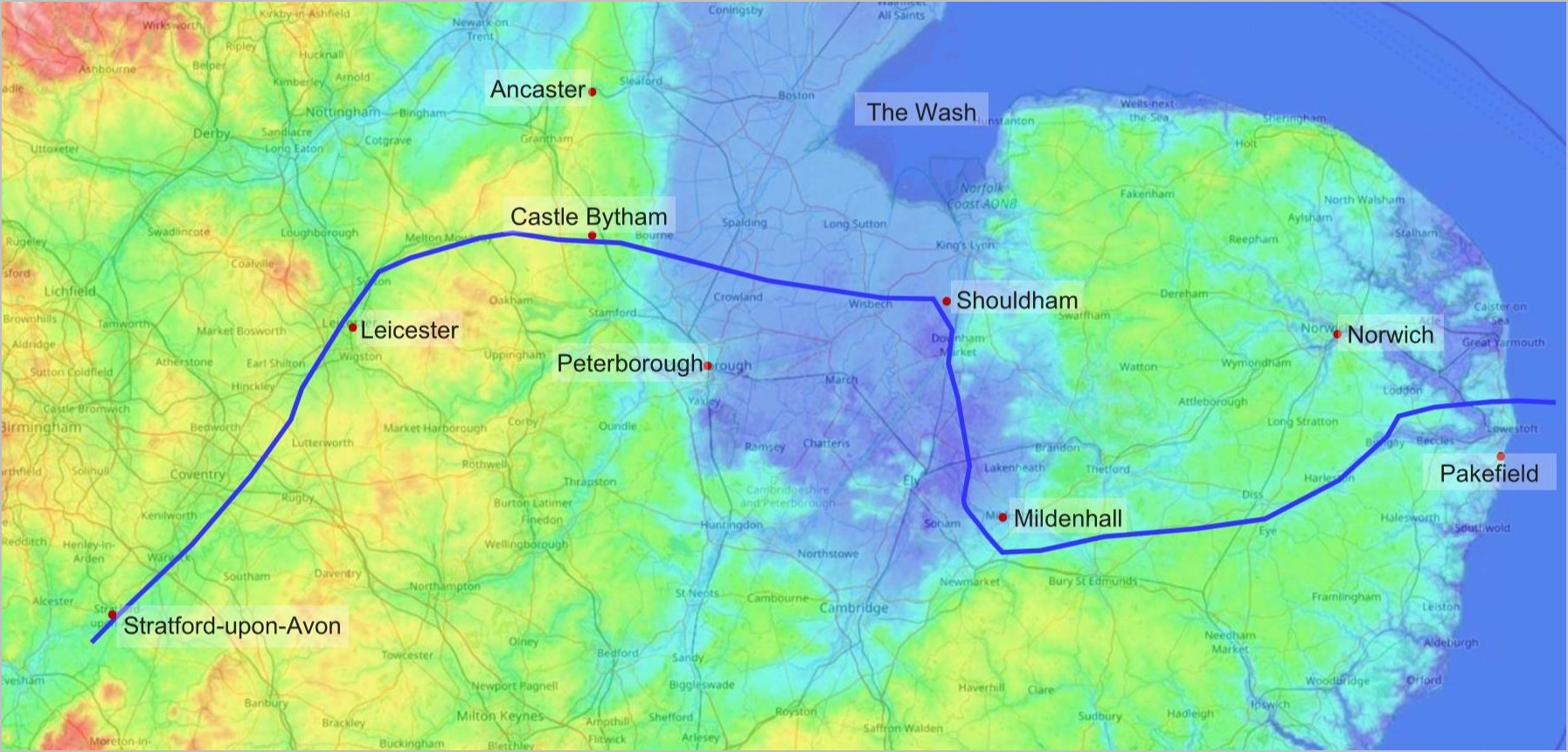River Bytham on:
[Wikipedia]
[Google]
[Amazon]
 The Bytham River is said to have been one of the great
The Bytham River is said to have been one of the great
Royal Society Publishing
(Open access), June 2022.
BBC:Tools unlock secrets of early man
{{coord, 52.526, 1.743, type:river_region:GB, display=title Geology of England Rivers of England Stone Age sites in England Archaeological sites in Norfolk Archaeological sites in Suffolk Archaeological sites in Warwickshire Archaeological sites in Lincolnshire Former rivers
 The Bytham River is said to have been one of the great
The Bytham River is said to have been one of the great Pleistocene
The Pleistocene ( ; referred to colloquially as the ''ice age, Ice Age'') is the geological epoch (geology), epoch that lasted from to 11,700 years ago, spanning the Earth's most recent period of repeated glaciations. Before a change was fin ...
rivers of central and eastern England until it was destroyed by the advancing ice sheets of the Anglian Glaciation around 450,000 years ago. The river is named after Castle Bytham in Lincolnshire
Lincolnshire (), abbreviated ''Lincs'', is a Ceremonial counties of England, ceremonial county in the East Midlands and Yorkshire and the Humber regions of England. It is bordered by the East Riding of Yorkshire across the Humber estuary to th ...
, where the watercourse is said to have crossed the Lincolnshire limestone hills in a valley now buried by Anglian till. West of that location, its catchment area included much of Warwickshire
Warwickshire (; abbreviated Warks) is a Ceremonial counties of England, ceremonial county in the West Midlands (region), West Midlands of England. It is bordered by Staffordshire and Leicestershire to the north, Northamptonshire to the east, Ox ...
, Leicestershire
Leicestershire ( ) is a Ceremonial counties of England, ceremonial county in the East Midlands of England. It is bordered by Derbyshire, Nottinghamshire and Lincolnshire to the north, Rutland to the east, Northamptonshire to the south-east, Warw ...
and Derbyshire. East of that location, the Bytham flowed across what is now the Fen Basin to Shouldham, then southward to Mildenhall, then eastward across East Anglia. It met the Proto-Thames in a delta near what is now the Norfolk/Suffolk border and flowed into the North Sea
The North Sea lies between Great Britain, Denmark, Norway, Germany, the Netherlands, Belgium, and France. A sea on the European continental shelf, it connects to the Atlantic Ocean through the English Channel in the south and the Norwegian Se ...
. Britain was then joined to the Continent by a land bridge and the Bytham joined the North Sea somewhere beyond the northern end of that land bridge.
Chris Stringer writes: "As the Bytham River slowed past Warren Hill n Norfolktowards its delta on what is now the East Anglian coast, it deposited sediments on the edge of the huge north-facing bay, into which the Rhine also flowed. The sites of Norton Subcourse in Norfolk and nearby Pakefield, just over the border in Suffolk, were probably both related to the Bytham, and they record a time when the climate of Britain was balmy and Mediterranean, and this part of East Anglia was a fertile estuarine plain."
The Anglian ice advance which followed, with its ice front reaching at least as far south as London and Birmingham, overrode all or most of the Bytham's catchment area. The course of the river was severed in the region of the Fen Basin. Following the ice retreat, the Bytham's remaining western section became part of the Trent catchment, and its remaining eastern section became a precursor of the Waveney river, running across East Anglia.
In the mid-2010s the existence of the Bytham was disputed. It was argued that an eastern section of the supposed river, flowing across central East Anglia, was indeed part of a pre-Anglian watercourse, but one which came from the north-west, through the Ancaster Gap in Lincolnshire. That "proto- Trent" river was severely disrupted by the Anglian glaciation. It has further been suggested that a western section of the supposed "Bytham river" was part of a ''post''-Anglian watercourse which flowed SW-NE from Warwickshire to the North Sea via The Wash. That "proto- Soar" river was also modified by glaciation, but in that case by the later Wolstonian ice advance. Those western and eastern sections never linked up to form a "Bytham river".
A later study asserted that the refutation of the existence of the Bytham is itself "contradicted by an abundance of evidence", and that sand and gravel deposits of the proto-Soar in Leicestershire could "only have been emplaced by a river flowing eastward across East Anglia" (ie, according to this study, by a large, ''pre''-Anglian river, the Bytham).
However, a detailed 2022 study of post-Anglian deposits in the Midlands estimates the age of the proto-Soar deposits ("Baginton sands") as around 150 ka - ie, as ''post''-Anglian, not pre-Anglian. This reinforces the refutation hypothesis.Gibson SM et al, ''Timing and dynamics of Late Wolstonian Substage ‘Moreton Stadial’ (MIS 6) glaciation in the English West Midlands, UK''Royal Society Publishing
(Open access), June 2022.
References
Further reading
*Gibbard, P.L., Pasanen, A., West, R. G., Lunkka, J.P., Boreham, S., Cohen, K. M. & Rolfe, C. 2009 Late Middle Pleistocene glaciation in eastern England. Boreas 38, 504–528. *Rice, R.J. 1981 The Pleistocene deposits of the area around Croft in south Leicestershire. Philosophical Transactions of the Royal Society of London, B293, 385-418. *Shotton, F.W. 1953 The Pleistocene deposits of the area between Coventry, Rugby and Leamington, and their bearing on the topographic development of the Midlands. Philosophical Transactions of the Royal Society of London, B237, 209-260.External links
BBC:Tools unlock secrets of early man
{{coord, 52.526, 1.743, type:river_region:GB, display=title Geology of England Rivers of England Stone Age sites in England Archaeological sites in Norfolk Archaeological sites in Suffolk Archaeological sites in Warwickshire Archaeological sites in Lincolnshire Former rivers